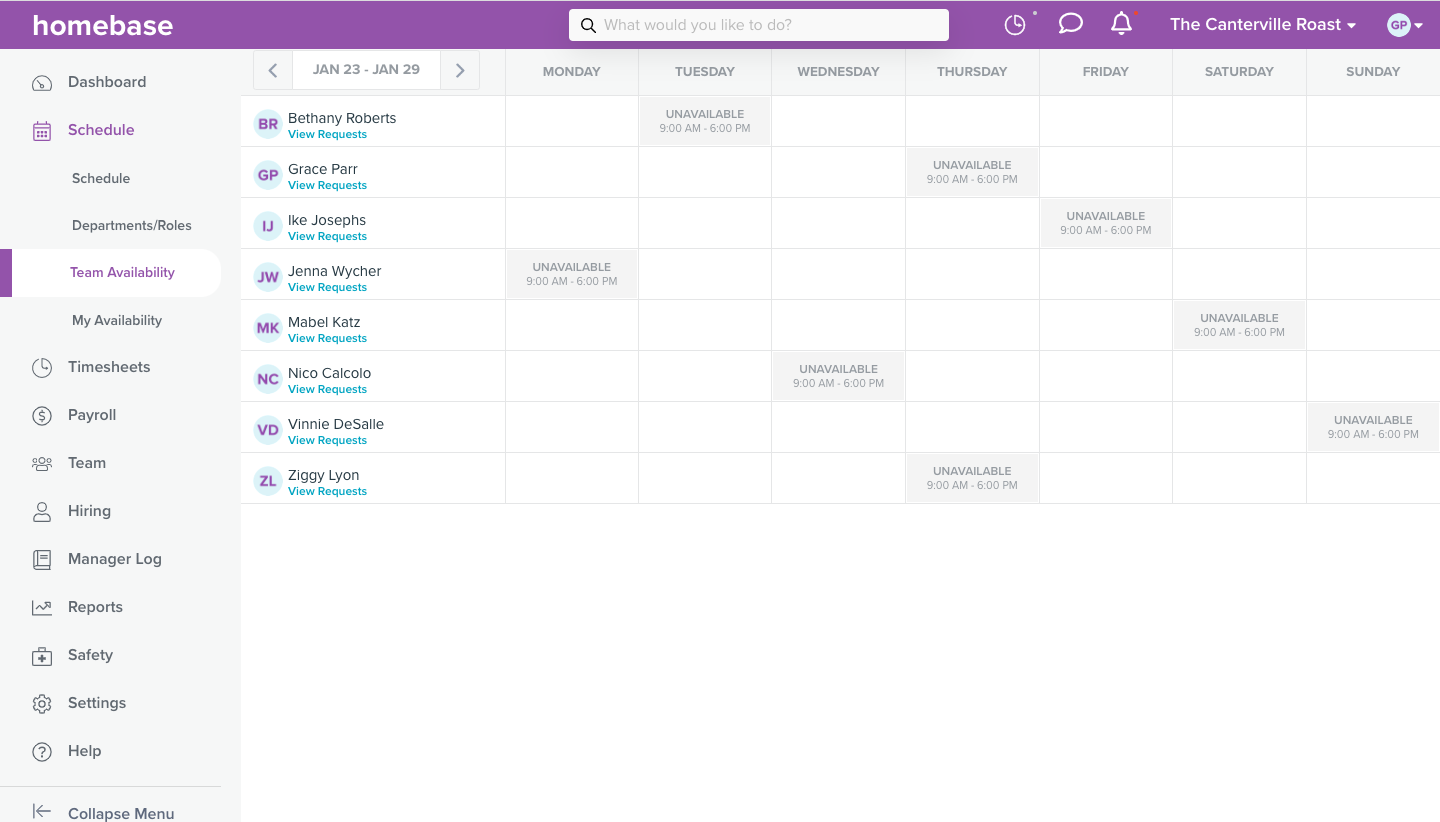Gone are the days when small businesses have to settle for strict 9 to 5 schedules with on-site staff and punch clocks. Now even independent shops and boutique firms can benefit from arrangements like remote and hybrid work, job sharing, and compressed workweeks.
One popular work arrangement to look into is flex time which is when teams choose their shift times.
But there’s a little more to flex time than that and it’s not suitable for every business. That’s why we’ve written this guide to explain what flex time is, its pros and cons, and which factors you need to consider.
What is flex time?
Flex time, short for ‘flexible time’, is a work arrangement where employees can choose their own hours within the limits you set. This means your team can adjust their shift start and end times to suit their personal needs and preferences.
For example, one employee could start at 7 AM and finish at 3 PM and another could work from 11 AM to 7 PM. All that matters is both team members work the hours agreed in their contract and complete all their tasks.
It’s worth noting that while ‘flex time’ and ‘flexible work arrangements’ have similar names, they are different. Flex time only allows staff to choose when they start and finish their shift each day. On the other hand, teams with flexible work arrangements can often decide their location, hours, and which tasks take priority.
This difference is why small businesses may prefer to use flex time over flexible work. You’re more likely to need staff on-site to handle customers but, with appointment-based scheduling, not necessarily for your entire opening hours.
What might flex time look like for my small business?
Let’s explore a few scenarios that show what flex time might look like for small businesses.
Imagine you own a salon with walk-ins and appointments. You have a junior team of stylists to handle customers off the street and the lower-priced services. Your most senior stylists get booked weeks in advance so you let them decide their own schedules.
Now, let’s picture a small delivery service. Customers can pick the day but drivers can make the delivery at any time between 7 AM and 9 PM. So, you tell your team they can work any of the eight hours within that timeframe provided all their goods get dispatched.
What to keep in mind when implementing flex time for your small business
If you think flex time might suit your business, here’s what you need to consider.
The kind of flex time
As you can see from the examples in the section above, flex time can vary between businesses. You should choose the type that’s most suitable for your staff and operations.
Here’s a list of the most popular kinds of flex time and when’s best to use them:
- Core hours: Employees work during a set period, perhaps 11 AM to 3 PM, but can adjust their start and end times around these hours. This works best if your business has daily meetings or collaboration sessions but otherwise doesn’t require staff on site.
- Split shifts: This is when teams can take an extended break during their shifts. If your business experiences a slump in the middle of the day, this can prevent you from being overstaffed.
- Staggered hours: Staff can work any continuous eight-hour period within your opening hours. If they have personal commitments like childcare or school, they can arrange their schedules around these plans. Your business can also benefit from staggered hours if you need coverage for long opening times.
Your guidelines and expectations
Since there are different types of flex time, staff may get confused about what they can and can’t do. They might not take advantage of the policy out of fear or mistakenly not show up to a shift.
That’s why it’s essential to create clear guidelines and explain your expectations to staff. For instance, you can state when you require them on-site, the reasons why, and how to record their hours. You can also write flex time policies in your employee handbook for teams to refer to.
If you’d like some guidance, Homebase has dedicated HR professionals that can advise you on the best policies for your business needs. We can also create your entire handbook based on a 30-minute phone call interview.
How to stay compliant
No matter when staff work, you need to record their hours and pay them correctly. Otherwise, you risk violating state and federal laws and incurring heavy fines.
However, tracking hours can become more challenging when teams are on flex time. You might not realize when employees have chosen to work late and when they’re on overtime. And if they exceed 40 hours a week, the Fair Labor Standards Act (FLSA) states that hourly workers must receive a higher rate.
The easiest way to get around this problem is by using an employee management app like Homebase. You can have staff add their preferred hours and create a flexible schedule ahead of time, whether that’s a week, a day, or an hour before. Then teams can simply use Homebase’s time clock to automatically track their hours and make sure they’re getting the correct pay.

Benefits of flex time for small businesses
If you’re on the fence about whether to implement flex time, it may help to understand the full benefits. Here’s what can happen if you give your team more choices over their hours.
Improved employee satisfaction and morale
Employees want flex time. According to a recent study, 33% of US workers would even change jobs if it meant they could choose their shift times.
That’s because picking their hours allows staff to allocate time for personal commitments more easily. They can run errands, care for family members or meet friends when it suits them. The end result is they feel less stressed about juggling their professional and private lives and are happier about coming to work.
Higher application and retention levels
As flex time is such a popular perk, you can attract more candidates to your business by advertising that you offer it.
The key word here is ‘advertise’. You have to tell job seekers about your flex time arrangement in your job adverts and at the interview. Homebase can help speed up this process by providing you with ready-made ad templates and posting your position across hundreds of job sites.
Flex time not only gets employees through the door but also convinces them not to leave. In fact, staff are 2.5 times less likely to look for another job than those with rigid schedules.
Lower labor-to-sales ratio
If you can use flex time to encourage staff to stop working during quiet periods, you can use your labor budget more effectively. For instance, if your salon experiences a slump in the mid-afternoon, you could offer stylists split shifts. That way you won’t end up paying staff to wait around and they won’t be bored.
However, it’s important to bear in mind your team’s full task list. Even if they’re not serving customers and clients, they may still need some quiet time to finish cleaning, admin, and preparation.
More productivity and efficiency
As well as saving costs, you may also find your profits increase as your team works harder. FutureForum found employees with flexible schedules were 39% more productive and a whopping 64% more focused.
This can positively impact your business in various ways. More efficient service means you can serve more people and thereby take more money. You may also find customers and clients rate your business more highly for its quick turnaround.
Over time, if you gain a reputation for your high-quality service, you may even be able to charge more than your competitors.
Potential drawbacks of flex time for small businesses
While flex time has many advantages, there are some challenges to be aware of. Here are some of the pitfalls to be aware of:
- Unsuitable for some industries: Roles like shop assistants, wait staff, and call center agents need to be constantly available to customers and clients. They usually perform their other tasks between sales or on either side of their shift which means there’s very little room for flexibility.
- Possible confusion and misunderstandings: Flex time can mean schedules are constantly changing and staff may cross paths less often. This can make communication more challenging and create more room for errors.
- Potential compliance issues: Some states have regulations that affect flex time. For example, California law states that employees must have a 30-minute meal period if they work over five hours in a day. Even if you offer staff split shifts, you still have to factor in this break.
Let employees decide their hours instead of watching the clock
Flex time is a game-changer for small businesses. Employees not only work at times when they feel most productive but find a healthier work-life balance and more job satisfaction. You also benefit from a more efficient team and a lower labor-to-sales ratio.
The challenge is scheduling and tracking hourly workers without underpaying them and risking compliance issues.
With the right tools and resources, you can implement flex time at your business effectively. Homebase helps you create policies for your employee handbook that suit you and your staff. Then we let you collect team availability in real-time and talk to them via the team chat so you know when everyone’s working. That means you get all the benefits of flex time without causing yourself extra work or stress.
Frequently asked questions about flex time
What does flex time mean?
Flex time refers to a scheduling arrangement that lets employees choose their shift times provided they fulfill the required hours and finish their tasks. This means they can tailor their timetables to align better with personal commitments or preferences. As a result, small businesses can also benefit from having more satisfied staff, higher retention, and improved productivity. If flex time also enables them to pool their resources more effectively, they can also save money on labor and operational costs.
What is an example of flex time?
One example of flex time is an agency that asks employees to work from 10 AM to 2 PM but otherwise lets them choose their own shifts. This might be because they have daily client meetings, collaboration sessions, or check-ins that require the whole team on-site. Hypothetically, one employee might choose to work from 10 AM until 6 PM but another could start at 6 AM and finish at 2 PM. Their shifts would only overlap during these core four hours in the middle of the day.
How many hours is a flex shift?
A flex shift is typically the same number of hours as a regular shift at your business. For example, if your standard work shift is eight hours, a flex shift will also be eight hours. The only difference is when employees work those hours as they have the freedom to choose.
